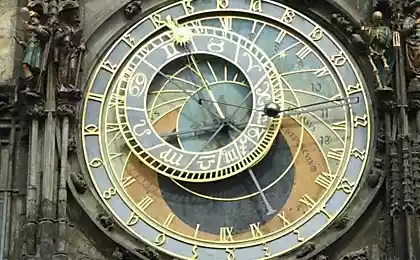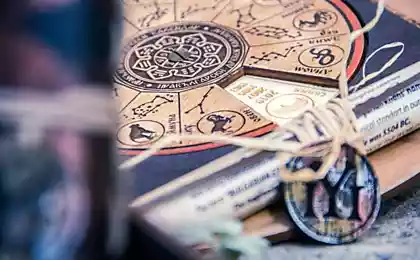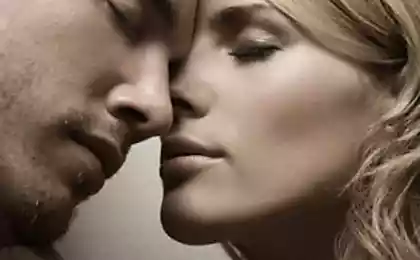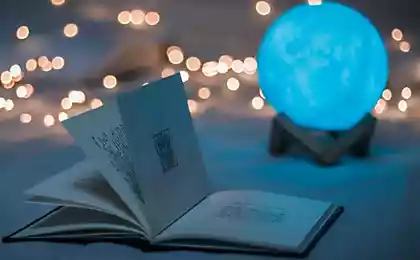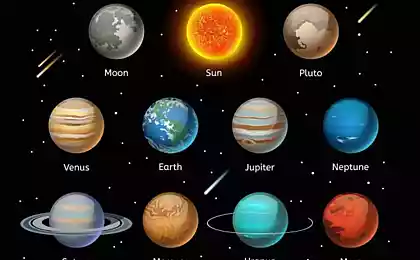793
The mission of "Mercury"
The planet Mercury is the smallest of the terrestrial planets (4880 km in diameter), and the closest to the Sun (58 million. Km., Or 3 mils, 2 light-minutes). In 1970 Mercury twice visited the spacecraft Mariner 10, and about 45% of the planet's surface was mapped. In 2004, NASA launched a new mission connected with the study of Mercury's surface. August 3, 2004 from Cape Canaveral was launched MESSENGER (Eng. MErcury Surface, Space ENvironment, GEochemistry and Ranging) -Auto interplanetary station (AWS) for the study of Mercury. MESSENGER is now in the final stages of many fly-gravitational forces of the Earth, Venus and Mercury. He is expected to be released on Mercury's orbit in March 2011 and twice circled around the planet, to significantly expand the knowledge of mankind on the surface of Mercury. This planet Minimal atmosphere, gravity is about 1/3 of the Earth's gravity and the surface temperature ranges from -183 Cº in some polar craters and to the midday heat in the 427 Cº (one day on Mercury equal to 176 Earth days).
13 ph via Big Picture
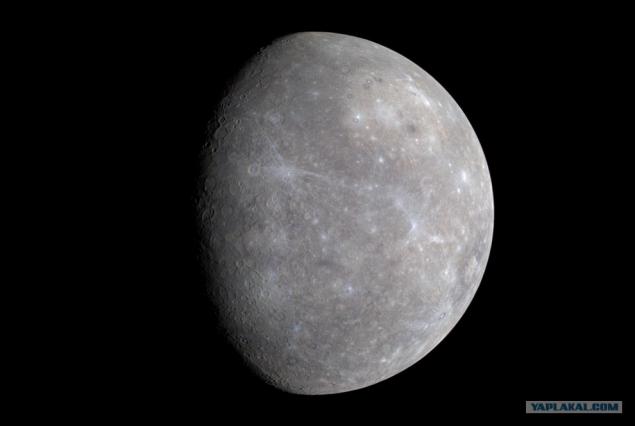
MESSENGER spacecraft made its first flight of the Mercury past (the minimum distance - 200 km) January 14, 2008, transferring detailed images of the surface. The color of the image was created by combining three images taken through three filters (IR, extreme red and purple). The three images were placed in a red, green and blue channels, respectively, to create a visualization presented here, creating a false color image, which emphasize the subtle differences of color on the surface of Mercury. (NASA / Johns Hopkins University Applied Physics Laboratory / Carnegie Institution of Washington)
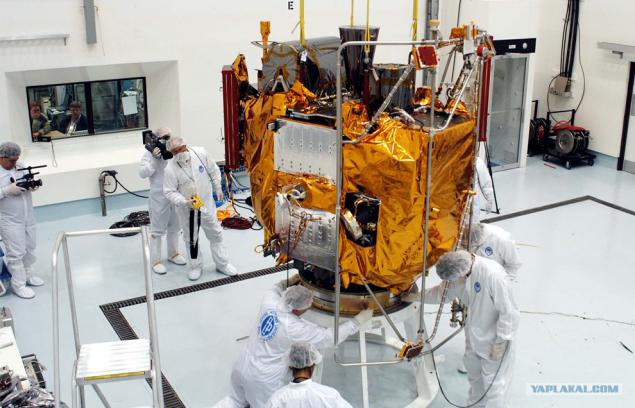
Workers Center Astrotech Space Operations at Space Center. Kennedy in Florida, check the placement of the spacecraft MESSENGER at the stand on March 10 2004. (NASA)

MESSENGER were loaded onto trucks to take them to the launch pad 17- B at Cape Canaveral on July 21, 2004. Later, he was paired with a heavy rocket Boeing Delta II launch to August 2nd. (NASA)

On the launch pad 17- B base of the Air Force at Cape Canaveral, the spacecraft MESSENGER rises to the top of the tower service, where it will connect the heavy rocket Boeing Delta II. 21 July 2004. (NASA)

After rolling back the mobile service tower technician looks up at the rocket Boeing Delta II, carrying the research probe MESSENGER, ready to launch a flight to the planet Mercury, scheduled for seven years. It was the second attempt to start two days after the first attempt to August 2, 2004, which was postponed due to bad weather. (NASA)

In the clouds of smoke rocket Boeing Delta II from the MESSENGER spacecraft successfully on board takes off from launch pad 17- B at 2:15:56 am EDT on August 3, 2004. (NASA)

This image was obtained for 89 minutes before closest approach MESSENGER to Mercury on October 6, 2008. It can be seen portions of the surface of the planet, which had not been seen before or since Mariner 10 nor with MESSENGER during its first approaching the Mercury. MESSENGER is 27, 000 km from Mercury, the scale of the picture 5 km / pixel. (NASA / Johns Hopkins University Applied Physics Laboratory / Carnegie Institution of Washington)

January 14, 2008 MESSENGER spacecraft passed 200 km above the surface of Mercury, and made the first shot of the part of Mercury that was not previously visible to the spacecraft. This picture was taken when the ship was at a distance of about 33, 000 km. (NASA / Johns Hopkins University Applied Physics Laboratory / Carnegie Institution of Washington)
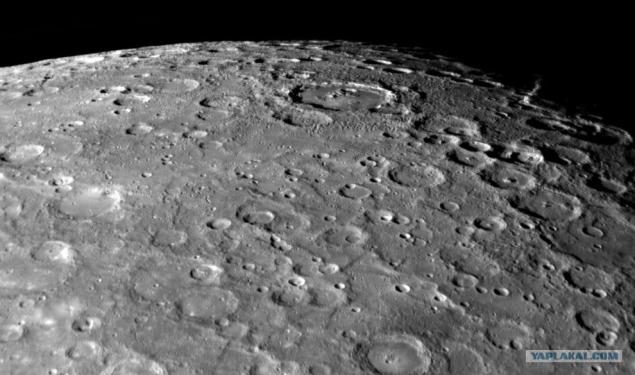
This picture was taken with narrow-angle camera MESSENGER during overflight Mercury on January 14, 2008. The surface of Mercury is represented by a scale of about 250 m / pixel. The outer diameter of large ring in the center of a double crater is about 260 km. The boat is likely filled with volcanic material. Also pictured are seen multiple networks of small secondary craters expanding radially from the double ring crater. Dual or multiple rings of very large diameter, which is often called closed stilling basin. On Mercury double ring basins formed when the crater diameter is greater than 200 km. (NASA / Johns Hopkins University Applied Physics Laboratory / Carnegie Institution of Washington)
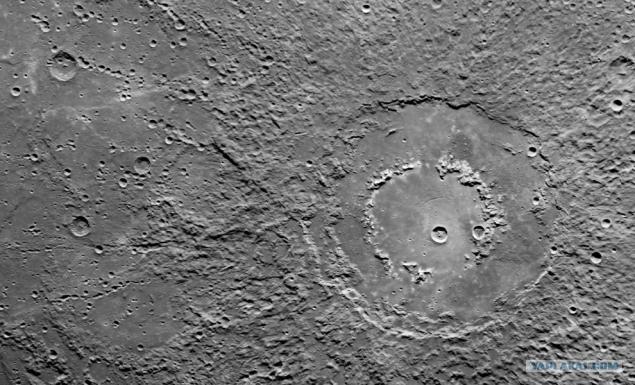
Named in honor of the Icelandic artist Julian Sveynsdottira crater Sveinsdottir (center) is superimposed on the Beagle RUPES is a distinctive feature of the landscape of Mercury. The picture was taken January 14, 2008 image. The unusual elliptical shape of the funnel due to the fact that an object hit the planet's surface at an angle. (NASA / Johns Hopkins University Applied Physics Laboratory / Carnegie Institution of Washington)

Picture taken October 6, 2008 during one of the bays around Mercury. One of the discoveries was the discovery of a huge crater, imprinted on this picture. This finding was named Rembrandt crater. Funnel diameter slightly less than 700 kilometers, according to scientists, was formed as a result of the bombardment of the planet about 3, 9 billion years ago (the so-called Late Heavy Bombardment - Late Heavy Bombardment). The surface of the crater crater remained intact - in contrast to other craters it is not filled lava formed by massive volcanic eruptions. Studying this 'virgin' territory has allowed scientists to learn much about Mercury's tectonic activity in the past and concluded that it was much more significant than previously thought. (NASA / Johns Hopkins University Applied Physics Laboratory / Carnegie Institution of Washington)

(NASA / Johns Hopkins University Applied Physics Laboratory / Carnegie Institution of Washington)

Source:
13 ph via Big Picture

MESSENGER spacecraft made its first flight of the Mercury past (the minimum distance - 200 km) January 14, 2008, transferring detailed images of the surface. The color of the image was created by combining three images taken through three filters (IR, extreme red and purple). The three images were placed in a red, green and blue channels, respectively, to create a visualization presented here, creating a false color image, which emphasize the subtle differences of color on the surface of Mercury. (NASA / Johns Hopkins University Applied Physics Laboratory / Carnegie Institution of Washington)

Workers Center Astrotech Space Operations at Space Center. Kennedy in Florida, check the placement of the spacecraft MESSENGER at the stand on March 10 2004. (NASA)

MESSENGER were loaded onto trucks to take them to the launch pad 17- B at Cape Canaveral on July 21, 2004. Later, he was paired with a heavy rocket Boeing Delta II launch to August 2nd. (NASA)

On the launch pad 17- B base of the Air Force at Cape Canaveral, the spacecraft MESSENGER rises to the top of the tower service, where it will connect the heavy rocket Boeing Delta II. 21 July 2004. (NASA)

After rolling back the mobile service tower technician looks up at the rocket Boeing Delta II, carrying the research probe MESSENGER, ready to launch a flight to the planet Mercury, scheduled for seven years. It was the second attempt to start two days after the first attempt to August 2, 2004, which was postponed due to bad weather. (NASA)

In the clouds of smoke rocket Boeing Delta II from the MESSENGER spacecraft successfully on board takes off from launch pad 17- B at 2:15:56 am EDT on August 3, 2004. (NASA)

This image was obtained for 89 minutes before closest approach MESSENGER to Mercury on October 6, 2008. It can be seen portions of the surface of the planet, which had not been seen before or since Mariner 10 nor with MESSENGER during its first approaching the Mercury. MESSENGER is 27, 000 km from Mercury, the scale of the picture 5 km / pixel. (NASA / Johns Hopkins University Applied Physics Laboratory / Carnegie Institution of Washington)

January 14, 2008 MESSENGER spacecraft passed 200 km above the surface of Mercury, and made the first shot of the part of Mercury that was not previously visible to the spacecraft. This picture was taken when the ship was at a distance of about 33, 000 km. (NASA / Johns Hopkins University Applied Physics Laboratory / Carnegie Institution of Washington)

This picture was taken with narrow-angle camera MESSENGER during overflight Mercury on January 14, 2008. The surface of Mercury is represented by a scale of about 250 m / pixel. The outer diameter of large ring in the center of a double crater is about 260 km. The boat is likely filled with volcanic material. Also pictured are seen multiple networks of small secondary craters expanding radially from the double ring crater. Dual or multiple rings of very large diameter, which is often called closed stilling basin. On Mercury double ring basins formed when the crater diameter is greater than 200 km. (NASA / Johns Hopkins University Applied Physics Laboratory / Carnegie Institution of Washington)

Named in honor of the Icelandic artist Julian Sveynsdottira crater Sveinsdottir (center) is superimposed on the Beagle RUPES is a distinctive feature of the landscape of Mercury. The picture was taken January 14, 2008 image. The unusual elliptical shape of the funnel due to the fact that an object hit the planet's surface at an angle. (NASA / Johns Hopkins University Applied Physics Laboratory / Carnegie Institution of Washington)

Picture taken October 6, 2008 during one of the bays around Mercury. One of the discoveries was the discovery of a huge crater, imprinted on this picture. This finding was named Rembrandt crater. Funnel diameter slightly less than 700 kilometers, according to scientists, was formed as a result of the bombardment of the planet about 3, 9 billion years ago (the so-called Late Heavy Bombardment - Late Heavy Bombardment). The surface of the crater crater remained intact - in contrast to other craters it is not filled lava formed by massive volcanic eruptions. Studying this 'virgin' territory has allowed scientists to learn much about Mercury's tectonic activity in the past and concluded that it was much more significant than previously thought. (NASA / Johns Hopkins University Applied Physics Laboratory / Carnegie Institution of Washington)

(NASA / Johns Hopkins University Applied Physics Laboratory / Carnegie Institution of Washington)

Source:
